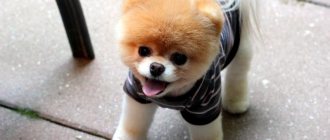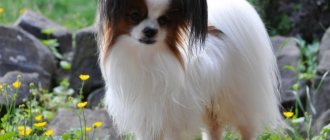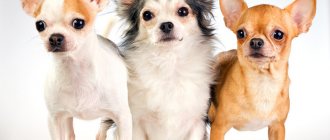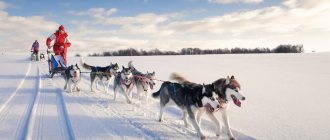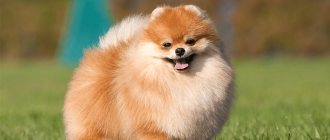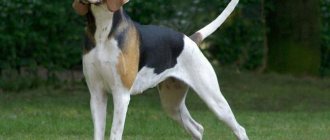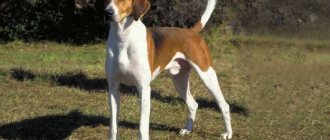Small dog breeds are ideal for keeping in small apartments. In addition to compact dimensions, they boast other advantages. But before purchasing a miniature family member, be sure to weigh the pros and cons, since such pets also have disadvantages. Focus not only on weight and appearance, but also on character, as well as care conditions.
What are the benefits of miniature dog breeds?
Based on weight and height at the withers, all pocket dogs are divided into 3 groups:
- small – 5-10 kg and 35-45 cm;
- dwarfs – 2-5 kg and 28-35 cm;
- toi – less than 2 kg and below 28 cm.
All of them are considered small pets.
Who are they suitable for?
Mini breeds make great companions and don't take up much space. For a comfortable life, even the tiniest studio apartment is enough for them.
Many of the small pets do not require complex care, so they are most often adopted by older people. Despite their activity and playfulness, such dogs are not suitable for small children. Noisy and awkward children can greatly frighten or injure animals during their games. For this reason, it is better to wait until the child goes to school and becomes more responsible.
Decorative dogs are suitable for inactive people, as they do not require a lot of walks. Despite this, they become very attached to their owners. Frequent and prolonged separation has a negative impact on the nervous system of tiny dogs, so it will be difficult for them in a home with workaholics.
Suitable for mini breeds and beginner dog owners. Unlike large dogs, four-legged babies have weakly expressed dominant behavior. This makes them easier to train.
Advantages and disadvantages
Below is a brief description of 30 small dog breeds with photographs. The advantages of these animals include:
- compact sizes, facilitating maintenance, care and travel together;
- small appetite, allowing you to save on food;
- no need for frequent and long walks;
- high life expectancy;
- possibility of training to the tray;
- safety for others.
A small pet who decides to attack a passerby is more likely to suffer himself than cause serious injury. Despite this, you should not neglect his upbringing.
Disadvantages include hyperactivity and problematic physiology. Four-legged kids often cause chaos in the house and become mischievous during training. Also, many of them suffer from allergies, dental problems and congenital pathologies.
How to choose a dog
Helpful tips for choosing a pocket dog:
- Decide on a specific breed. In this case, it is necessary to take into account not only appearance, but also character. Difficulties in grooming (length and structure of coat, etc.) are important.
- Choose a good nursery or a reliable, trusted breeder that has many positive reviews.
- Do not try to buy the tiniest dog possible, since dwarfism is always associated with major health problems.
- Do not buy an animal from an advertisement or from someone else, as there is a high probability of buying a counterfeit animal. Unscrupulous breeders often overestimate the age of puppies, claiming that they will be miniature. This way you can buy an ordinary medium-sized dog or, even worse, a known sick animal.
- Be sure to look at the parents, their living conditions and documents (pedigree, exhibition diplomas, etc.).
- Decide on the purpose of purchasing a pet (just for the soul, for breeding, for exhibition activities).
The smallest dog breeds in the world
The lower limit of the weight of these dogs is no more than 3 kg. They easily fit into a handbag, so they are very convenient to take with you on the road.
Chihuahua (450 g-3.5 kg)
The record holder for weight was the Chihuahua Millie, who was included in the Guinness Book of Records. As an adult, she weighed only 450 g, and her height at the withers was 9.65 cm.
All Chihuahuas adore their owners and are constantly jealous of them. Despite their modest dimensions, these kids are real badasses. They are not at all afraid of the physical and numerical superiority of the enemy, therefore, in order to avoid injuries during walks, it is better to keep the Chihuahua on a leash.
Yorkshire Terrier (1.35-3.2 kg)
Charming Yorkies are gentle creatures with the characteristic energy and endurance of a terrier. They are easy to train and get along very easily in the same home with other animals.
Particular attention will have to be paid to the silky fur of the Yorkie. Depending on the length, it needs to be washed every week or once every 2-3 weeks.
Prague rat (1.5-3.5 kg)
Despite the lack of international recognition, rat dogs are very popular among dog breeders. These intelligent and slightly prim animals love sports, so it is recommended to channel their energy into agility.
Ratfish are practically devoid of undercoat. Because of this, they catch cold easily at temperatures below 0°C. Warm clothing helps prevent hypothermia.
Japanese Chin (1.8-3.5 kg)
Graceful and graceful Japanese Chins are the calmest and most balanced representatives of mini-breeds. They get along well with children, but cannot stand familiarity. Too rude behavior on the part of a child can lead to retaliatory aggression.
Japanese Chins are very clean and do not need fashionable haircuts. The only caveat is intolerance to hot weather. In summer, it is better to take such pets outside in the early morning or late evening.
Chinese Crested (2.3-5.4 kg)
Chinese Cresteds are sensitive to human emotions. They always notice the mood swings of their owners and seem to predict their desires.
This funny hairless dog practically does not shed and does not have the characteristic dog smell. Their delicate skin is very vulnerable to cold and sun rays, so they should be taken for walks in clothes.
Lancashire Heeler (2.5-5.5 kg)
Heelers are a young breed, registered in 2016. When breeding them, Welsh corgis and terriers were used. From their closest relatives, these dogs have inherited good working qualities, diligence and restlessness.
Healers quickly remember new commands, but lack long endurance. Treats help keep their attention.
Affenpinscher (2.9-6 kg)
Bearded Affenpinschers with a monkey face do not tolerate other four-legged animals, but they also do not tolerate loneliness. These pets are literally fixated on their owners and do their best to prevent the appearance of third parties.
The shaggy appearance of Affenpinschers is maintained with periodic trimming and trimming. Particular attention is paid to shortening the beard, which very often gets dirty while eating.
Maltese (3-4 kg)
Snow-white Maltese dogs have a doll-like appearance and a perky character. They love to frolic and play pranks with other four-legged animals, but they will never share the attention of their owner with them.
After washing, the Maltese coat is wound into curling irons to protect the hairs from tangling. A silk jumpsuit also saves you from tangles.
Bolognese (3-4 kg)
Bolognese, or Italian lap dogs, are very playful and dependent on human attention. Prolonged loneliness harms their psyche. If you often disappear at work, then be sure to get another four-legged bolognese for company.
Italian lapdogs need to be brushed daily, as their curly coat quickly collects dirt. To maintain its ideal shape, the fur coat will have to be trimmed once a month.
Bichon Frize (3-5 kg)
Curly-haired Energizers are very sociable and friendly. Due to these qualities, they are often attracted to pet therapy in nursing homes.
The lush coat of the Bichon Frize practically does not shed, but after each walk, dirt and debris remain in it. Because of this, dogs have to be brushed every day.
Russian Toy (Toy Terrier)
"Smooth-haired Russian Toy Terriers"
The Russian Toy (Toy Terrier) is a very small breed of dog, bred in Russia from the English Toy Terrier. These playful, cheerful dogs have an unusual, attractive appearance and attract all dog lovers. With docked tails, they resemble miniature, slender fawns. Russian Toychiks have their own specific nuances in education, maintenance and feeding. Therefore, if you want to have such a pet, first of all, you need to study all the intricacies of the breed in order to raise a healthy pet. Based on the type of coat, toy terriers are classified as smooth-haired and long-haired. Average weight is about 2 kg.
Small dog breeds weighing up to 10 kg
This TOP 10 includes several more dwarfs and representatives of small breeds. Their weight parameters are more impressive than the previous group, but still fit into 10 kg.
Schipperke (3-9 kg)
The smallest representative of shepherd dogs with a fluffy collar on his neck is an excellent watchman. He is suspicious of strangers and always notifies his owners of their appearance.
The Schipperke's thick coat repels dirt and water. It should only be washed when necessary. There are no problems with shedding either. Despite the abundant hair loss during this period, its duration is extremely short.
Papillon (3.2-4.5 kg)
The Papillon's ears resemble the wings of a butterfly. These dogs are very active, get along well with cats and are ranked 8th among the smartest dogs.
Papillon coats should only be brushed after being thoroughly moisturized. Otherwise, it becomes brittle and falls out.
Pekingese (3.2-6.4 kg)
The extraordinary appearance and peaceful nature of the Pekingese explain the large number of their fans. But for small children it is better to choose someone more affectionate, since these animals do not tolerate too close contact.
Frequently washing Pekingese dogs aggravates their shedding and damages the hair structure. To maintain a spectacular coat, animals are washed no more than once a year or before an exhibition.
Italian Greyhound (3.5-4.5 kg)
The playful Italian greyhound loves tactile communication. She shows her love with hugs, kisses and gentle licking.
It is recommended to direct the energy of a small greyhound into sports: agility or coursing. Otherwise, the Italian greyhound spends it right at home, destroying everything within its line of sight.
Belgian Griffon (3.5-6 kg)
The main advantage of griffons is their human orientation. They adapt to any owners and subtly sense their mood.
Belgian Griffons do not require frequent walking, and trimming is sufficient to care for their coat. Not only elderly owners, but also people with disabilities can cope with this.
Shih Tzu (4-7.2 kg)
Shih Tzus love to snuggle on their owners' laps and are very trusting of strangers. They see a friend in every person, so you should not rely on the guard qualities of these four-legged animals.
The beautiful fur of the Shih Tzu quickly falls off. Daily combing helps to avoid the formation of tangles.
Pug (6-8 kg)
Friendly and loving, Pugs are extremely affectionate with people. Loneliness makes them depressed. It’s better to take them with you during your vacation or leave them in the care of friends.
The folds on the skin of pugs require special care. They need to be regularly cleaned of dirt and dust to avoid the development of infections and inflammations.
Jack Russell Terrier (6.4-8.2 kg)
Cheerful and friendly terriers do not get along well with other animals due to their developed hunting instinct. They often engage in skirmishes with representatives of their own species, not paying attention to the size of the enemy.
Despite their miniature size, terriers need active physical activity. With insufficient training, all the energy of these “energizers” is directed to pranks.
Beagle (9-10 kg)
With their hyperactivity, beagles are reminiscent of Jack Russell terriers. They also need frequent walks and active games to prevent the apocalypse inside the apartment.
Beagles tend to be overweight. Regular physical activity and adherence to daily calorie intake help to avoid obesity.
Welsh Corgi Pembroke (10-13 kg)
Corgis are characterized by high intelligence and amazing endurance. They love children, are not prone to dominance and are sensitive to the mood of their owners.
The Corgi's spine is very vulnerable. These animals are prohibited from jumping from great heights and intense loads that affect the spinal discs.
Chihuahua
"Chihuahua"
Named after the Mexican state of Chihuahua, these loyal and energetic dogs prove that good things come in small packages—about 2 pounds to be exact. The Chihuahua is considered one of the smallest dog breeds. Despite their size, these dogs are full of character, they are quite independent and independent, but they are attached to their owner, whom they can wait for a long time and meet very emotionally. Chihuahuas tolerate travel well and make excellent companions on long walks.
Mini versions of medium and large breeds
Separately, we should highlight the breeds of small dogs obtained by crossing medium and large dogs. Such pets are suitable for those who do not have a large home, but dream of a four-legged pet with a certain character and appearance.
Pomeranian Spitz (1.9-3.5 kg)
Thanks to the efforts of German dog breeders, a miniature Pomeranian was obtained from a 15-kilogram Spitz, which conquered Queen Victoria herself. The final standard for Pomeranians was established by the FCI in 1998.
Curious fidgets become very attached to their human family. They love to haze other animals, demonstrating their superiority.
Miniature dachshund (2.5-3)
The creation of the mini-dachshund solved the problem of rabbit hunting. Before their appearance, there were only standard representatives that crawled exclusively into large holes of foxes and badgers.
Dwarf dachshunds have a developed hunting instinct. On walks, they stick their curious nose into all the holes they find. A small amount of activity and prolonged loneliness have a destructive effect on dachshunds. If you have a busy work schedule, it is better to choose someone calmer.
Toy Poodle (less than 3 kg)
This tiny four-legged dog differs from the standard poodle only in its size. Thanks to his extraordinary intelligence, he is also easy to train and easily predicts the desires of his owners.
The poodle's thick coat is brushed daily. Otherwise, it quickly becomes tangled.
Miniature Pinscher (3.5-5 kg)
Despite the similarity with the Doberman, the miniature's closest relatives are German pinschers, dachshunds and Italian greyhounds. This self-confident and courageous pet needs an experienced owner who can suppress innate dominance and attempts at manipulation.
The miniature's coat is combed weekly, but bathing is carried out only as needed. The rest of the time, wipe the fur coat with a damp cloth made of natural fabric.
Pomsky (5-7 kg)
Pomskies, bred by mating a Pomeranian and a Husky, are still not recognized by cynological organizations, but this does not affect their popularity. These animals are very self-sufficient and freedom-loving. They easily tolerate loneliness and constantly try to sneak away from their owner during a walk.
The Pomsky's coat does not mat. To maintain a neat appearance, it is combed 1-2 times a month.
Miniature Schnauzer (5.4-9.1 kg)
The mini version was developed by crossing Schnauzers with Miniature Pinschers, Spitz, Poodles, Affenpinschers and Terriers. These four-legged animals have good guard qualities, so they can be used to guard the house.
Miniature Schnauzers do not shed. Lost hairs are removed from their coat with a trimmer.
Cavalier King Charles Spaniel (5.9-8.2 kg)
The Cavalier King Charles is a revived English Toy Spaniel, excluding crossbreeding with Pugs and Japanese Chins. The curious fidget is so friendly that any stranger can easily bribe him with affection or playing together.
When caring for a toy spaniel, you should pay special attention to its ears. They are poorly ventilated and require daily cleaning.
Sheltie (6.4-12 kg)
Although similar to collies, the ancestors of Shetland Sheepdogs are Border Collies and King Charles Spaniels. Shelties are very vulnerable and shy. Contrary to popular belief, such a pet is not suitable for a family with a small child.
When wet, the Sheltie's coat practically does not smell like a dog. To maintain a neat appearance, it is enough to wash it only 2-3 times a month.
Alaskan Klee Kai (7.3-10 kg)
A smaller version of the husky was created by mating the smallest individuals with Eskimo dogs and Malamutes. The Klee Kai received international recognition in 1995.
These animals are very sociable and humane. They show distrust and caution only towards strangers.
Mini Bull Terrier (9-15 kg)
Mini Bull Terriers were recognized by the English Kennel Club in 1939. Unlike their ancestors, these kids are very sociable and friendly even towards strangers.
The hair of mini bulls repels dust, and the scanty undercoat does not get tangled. To maintain the neat appearance of these pets, it is enough to comb them weekly with a massage glove.
Do you like the article? 268
Pomeranian Spitz
"Pomeranian Spitz"
Don't be fooled by these miniature, rounded balls of fur with funny snub-nosed faces, which are often called bear cubs. The Pomeranian Spitz easily finds a common language with the owner, for whom he experiences boundless love and loyalty. He will become a wonderful friend and companion for already conscious children. Be prepared that dogs of this breed love to bark, which quite bothers their neighbors, and often even their own owners. The Pomeranian's playful behavior will keep you active on short daily walks. The average weight of this small dog is about 3 kilograms.
Japanese Chin
These handsome guys have strong protective and protective qualities in their blood. Small but brave - this is definitely about the Japanese Chin. This is the case when a cute appearance can be deceiving: the dog will not tolerate familiarity from strangers. But Chins are very attached to their family, and to all its members at the same time.
It is important to start socializing your Japanese Chin as early as possible. If this is not done, then the puppy will be wary and timid, and each new acquaintance will turn into great stress for him.
The Chin does not tolerate intrusiveness and loud, sharp sounds, so it is better not to take this breed into a family with small children. But for an elderly person, a fluffy dog will become a faithful companion. There is no need for rigidity and intransigence when communicating with a Chin; he can be an excellent option for a novice dog owner.
Rat Terrier (American Rat Terrier)
"Rat Terrier (American Rat Terrier)"
The Rat Terrier is an American breed of miniature dog that was originally used to catch rodents. Today they are more often taken as companions. Rat terriers can be either small or medium in size, weight varies from 5 to 15 kg, and height at the withers is 36-58 cm. The rare breed is not recognized by the FCI, only by several American Kennel clubs. Rumor has it that Teddy Roosevelt came up with the name for this pint-sized terrier. In addition to being excellent rat catchers (hello, city dwellers), they are energetic, loyal, obedient and cheerful, and have silky smooth coats.
Yorkshire Terrier
"Yorkshire Terrier"
Yorkshire Terrier is one of the decorative dog breeds popular all over the world. Dogs of this breed are distinguished by their mobility and energy, justifying their origin from terriers, and their luxurious exterior and miniature size have made them popular not only in cities, but also in rural areas. The average height of Yorkies at the withers ranges from 15-17 cm, and weight – 1.7-3.1 kg. These friendly and sociable creatures are distinguished by their insightful mind and good trainability, aesthetic appearance, and another undoubted advantage - these small dogs are hypoallergenic due to their special coat.
English cocker spaniel
"English Cocker Spaniel"
These spaniels weigh a little more than their popular American counterparts, but their cheerful personalities win over families just as easily. Like all British aristocrats the English Cocker Spaniel carries itself with unprecedented dignity, but once you take him outside and start playing with him, his cheerful character and lively temperament with a constantly wagging tail will bring many positive moments and will force you to explore all around with this happy “tourist”! Without a doubt, he will become an excellent friend and devoted companion to your family. The English Cocker Spaniel's height at the withers is about 40 cm and its weight is 14 kg.
Maltese
Glamorous dogs were also loved by French kings. Through the centuries, this breed carried an absolute inability to live independently - they did not need this, because even in the most difficult times, the Maltese was cared for and cherished. Initially, the breed was distinguished by its eccentric disposition, but over time it transformed into the calmest representatives of the canine world.
Maltese do not get along with any other pet. Play outside - please, but as soon as the owner shows even a little attention to someone else's animal, furious jealousy turns on.
This is another breed whose representatives cannot stand being alone. If you plan to leave your Maltese alone for more than a couple of hours, then prepare for the bedlam that he will cause.
The dog copes with stress in its own way and chews everything it can reach: shoes, baseboards, wires and everything else. Therefore, the Maltese is unlikely to be suitable for working people as a pet.
Papillon
A distinctive feature of the breed is the shape of the ears, which resemble the open wings of a butterfly. These small dogs are known for their excellent intelligence and ability to accept training.
Like most small dogs, Papillons do not like to be left alone. If you are forced to leave him alone with you, then try to provide him with a variety of toys: rubber balls, vein bones.
Papillons should never be overfed. This breed is prone to obesity, which can lead to major health problems. In an adult Papillon, the ribs can be felt; if not, this is a reason to reconsider the diet.
Playing between a Papillon and a child is possible, but must be supervised by adults. The dog perceives the child as an equal, so he may bite if he is offended. Early socialization is important for the breed, because an untrained Papillon can behave aggressively when it grows up.
Chinese Crested
When studying the names of small dog breeds , pay attention to the Chinese Crested Dog. It is definitely impossible to confuse it with any other breed in the world, these miniature dogs have such a specific appearance. Some adore them, others are disgusted, but no one is indifferent. The hair covers only the head, paws and tail of the Chinese Crested. The rest of the body appears completely naked.
But such an unusual appearance has clear advantages: the Chinese Crested Dog does not cause allergic reactions, does not shed and has almost no unpleasant odor. The character is characterized by friendliness, intelligence and playfulness.
To teach a representative of the breed any commands, it is better to turn to dog handlers - the mission is not easy, requiring a thorough approach and special knowledge. Chinese Cresteds learn commands, but with difficulty.
Two more features of hairless dogs are the need for their own wardrobe and careful skin care. These dogs do not cause allergies in their owners, but they themselves are very prone to skin diseases, including allergic ones. Therefore, Chinese Cresteds need to be washed only with special products, and their diet should be selected very carefully.

